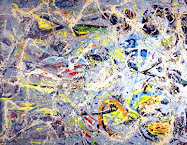Today, of all days, you can give yourself permission to go out to the studio and make a huge mess, step in it, and basically cut loose!
Jackson Pollock was born 100 years ago today in Cody, Wyoming, to Presbyterian Irish and Scotch-Irish farmers. He changed the world.
Telegraph Article on the centenary of Pollock's birth.
What follows is my research post on Jackson Pollock, which has been beviraled by Google and utilized by thousands of university students as a starting point for their studies.
 Galaxy, 1947Jackson Pollock
Galaxy, 1947Jackson PollockOriginality was the hallmark of Jackson Pollock's art. He found a way to both connect with, and yet break free of whatever else had been happening with art. It's a little hard to appreciate the originality of Pollock from our high horse of retrospection. I liken it to some of my experiences with rock climbing. Sure, a particular rock climb will have a difficulty rating and a status as severe or hard, but when you go to climb it, you feel that it isn't as hard as described. Well, put yourself in the sticky shoes of the very first ascensionist. What was the experience like for him?
So, imagine the first "pure" abstraction. How does one completely eliminate the subject from a painting? The Abstract Expressionists often likened abstract painting to getting "in touch" with your inner child, because children draw and paint with freedom and innocence. I argued with that comparison until I had my own children picking up pencils and crayons. Now, I completely believe in the childlike aspects of abstract visual expression. Now, I just have to work out my objections to the "primitive man" comparisons to painting abstraction.
My own experience with abstraction took place when I took a workshop from Diane Townsend, who happens to be a great abstractionist with ties to New York and my hero Wolf Kahn.
How do you begin painting abstractly? Townsend unlocked that door for me, and before noon on the first day I was having a great time painting "nothing". I hope to continue my exploration of abstraction in the near future. It actually can be one of the hardest styles to paint in and make anything really good. My abstracts can be seen here and here.
Let's follow some link paths for Jackson Pollock.
Steven Naifeh and Greg Smith have written a Pulitzer prize winning biography titled: Jackson Pollock, An American Saga. I have some serious misgivings about it's historicity, but suffice it to say that it seems to be the "go to" book now for looking at his life. Ed Harris brings it to our attention in his comments about his movie about the keen artist.
Harris also thinks Pollock may have been manic-depressive. Of course, my first inclination would be to look up the paperwork on his 4-F status, just in case that might reveal something about a diagnosis of this or something similar. I guess he also saw therapists, and the records from that probably reveal something, too. Shades of van Gogh.
Don't miss the Pollock-Krasner House and Study Center in East Hampton (Long Island). This small property with rustic facilities was purchased by Pollock and Krasner with help from Peggy Guggenheim, who was Pollock's "super-patron". It was here that Pollock began his drip paintings, and you may visit this museum and walk on the floor where his drips are preserved. Could these be considered accidents?
I recommend the Pollock bio written by the director of the P-K House, Helen Harrison.
There is a Pollock-Krasner Foundation, which I think is a very classy move by the late Lee Krasner, who was left as a widow by her drunken and cheating genius-artist husband. Trying to figure out what made Krasner's relationship with Pollock tick is an exercise in head-trips that some may enjoy. We'll look at the wonderful Krasner a little later in our Abstract Expressionist study this month.
The National Gallery of Art in DC has a good site about the old boy. A quick look at his process is seen in this GIF - Video. Here's a Quicktime featurette of a Hans Namuth film of the Camel-smoking curmudgeon at his task of working a horizontal canvas.
I have to limit the scope of JP references found at the Museum of Modern Art, since they are numerous. Man, this stuff is knee-deep. How does one have an "itinerant childhood"? Uh, never mind the MoMA for now...
Of course, my favorite site for Jackson Pollock is the fun and interactive "Create Your Own" Jackson Pollock by Milos Manetas. It's an ingenious flash page where you drip "paint" on your CRT screen. Of course, you don't control the color - those come as accidents. My only advice is cut loose, don't stay inside the frame, and don't stop too soon!
Links referenced above:
http://www.amazon.com/Jackson-Pollock-American-Steven-Naifeh/dp/0913391190
http://naples.cc.sunysb.edu/CAS/pkhouse.nsf
http://naples.cc.sunysb.edu/CAS/pkhouse.nsf/pages/pollock
http://www.pkf.org/
http://www.nga.gov/feature/pollock/index.htm
http://www.jacksonpollock.org/


































